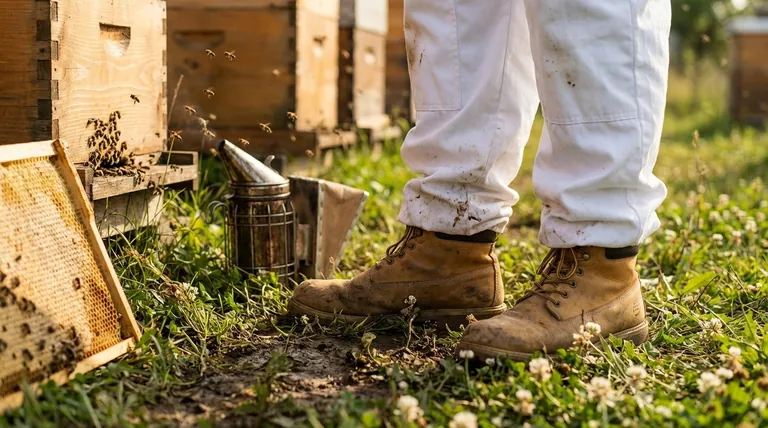When choosing beekeeping shoes, the best options provide complete protection from stings, offer excellent support for long periods of standing and lifting, and are easy to clean. Your primary goal is to create an impenetrable barrier, which means any footwear with holes, mesh, or porous fabric is fundamentally unsafe for use in an apiary.
The right footwear isn't just about comfort; it's a critical piece of safety equipment. Your choice should prioritize complete sting protection and physical support to ensure you can work confidently and without injury.

The Anatomy of an Ideal Beekeeping Shoe
Choosing the right shoe is about understanding the specific demands of the bee yard. From angry guard bees to heavy honey supers, your feet face unique challenges that standard footwear isn't designed to handle.
Absolute Protection: No Entry Points
The most important feature is impenetrable material. Bees are experts at finding small openings, and a single sting to the foot can end your inspection early.
Avoid shoes with any type of perforation, like clogs (Crocs), or breathable mesh panels commonly found on running shoes. A bee’s stinger can often penetrate thin canvas or fabric.
Stability and Support: The Foundation for Heavy Lifting
Beekeeping involves lifting heavy hive components, often weighing 50 pounds or more. This requires footwear that provides excellent ankle and arch support.
Look for shoes with sturdy soles and comfortable, padded insoles. This design helps distribute pressure evenly and reduces fatigue during long hours in the apiary.
Practicality in the Apiary: Grip and Cleanliness
You will be walking on uneven ground and dealing with sticky honey or wax. Your shoes must be practical for this environment.
Slip-resistant soles are essential for maintaining your footing. Additionally, choose a material like leather or rubber that is easy to wipe clean of mud, honey, and propolis.
Proper Coverage: Securing the Weakest Link
The connection between your bee suit and your footwear is a common entry point for bees. The shoe must be tall enough to ensure a secure overlap.
Ankle-high boots are ideal because they allow the elastic cuffs of your suit's pant legs to fit securely over the top, creating a bee-proof seal.
Understanding Common Footwear Choices
Different types of shoes offer a mix of these features. Understanding their specific strengths and weaknesses is key to making an informed decision.
Leather Work Boots
These are often considered the gold standard. They provide excellent sting protection, great ankle support, and are highly durable. Their primary drawback can be a lack of breathability in hot climates.
Rubber Boots (Wellies)
Rubber boots are completely sting-proof and exceptionally easy to clean. They are a fantastic choice, especially in wet conditions. However, they can lack breathability and may not offer the same level of arch support as a work boot unless you add aftermarket insoles.
Hiking Shoes
While comfortable, most hiking shoes present a risk. Many feature breathable mesh panels that a bee can sting through. Only consider them if they are made entirely of leather or a similar non-porous material and offer ankle-high coverage.
What to Strictly Avoid
Never wear clogs, sandals, canvas sneakers, or any shoe with an open-toe or mesh design. These offer virtually no protection and are a serious safety hazard in the bee yard.
Making the Right Choice for Your Goal
Your final decision should balance protection, comfort, and the specific conditions of your apiary.
- If your primary focus is maximum protection and support: Choose a high-quality, ankle-high leather work boot.
- If your primary focus is ease of cleaning and wet conditions: Opt for rubber boots (Wellies), and consider adding supportive insoles for comfort.
- If you are working in a hot climate: Look for lighter-colored leather or uninsulated rubber boots to help manage heat.
Ultimately, the right footwear gives you the confidence to focus on your bees, not on your feet.
Summary Table:
| Feature | Importance | Ideal Choice |
|---|---|---|
| Absolute Protection | Prevents bee stings; no holes or mesh. | Leather or rubber boots. |
| Ankle & Arch Support | Reduces fatigue from lifting heavy supers. | Sturdy work boots with good soles. |
| Slip-Resistant Sole | Provides stability on uneven ground. | Boots with deep tread patterns. |
| Easy to Clean | For removing mud, honey, and propolis. | Smooth rubber or leather material. |
| Proper Height | Ensures secure seal with bee suit. | Ankle-high or higher boots. |
Ready to suit up safely? Your apiary's safety starts from the ground up. At HONESTBEE, we supply durable, protective beekeeping footwear and equipment designed for the demands of commercial beekeepers and distributors. Get the right gear to work confidently.
Contact our wholesale team today to discuss your beekeeping supply needs!
Visual Guide

Related Products
- Cotton Beekeeping Suit and Round Hat with Veil Bee Keeper Protective Gear
- White Beekeeping Protective Suit and Hat with Fencing Veil for Beekeepers
- Professional Beekeeping Suit for Kids and Girls Childrens Bee Keeper Suit
- Beekeeper Cowboy Hat and Veil for Beekeeping
- High Performance Plastic Queen Excluder for Beekeeping and Apiary Management
People Also Ask
- Why is white the predominant color in bee suit designs? | Key to Hive Calm & Beekeeper Safety
- How should a bee suit be cleaned? Protect Your Investment and Ensure Apiary Safety
- What should be considered regarding the color of beekeeping clothing? Ensure Your Safety and Keep Bees Calm
- Do beekeeping suits completely prevent stings? Maximize Your Apiary Safety with the Right Gear
- What factors should be considered when choosing a beekeeping suit? Balance Safety, Comfort & Performance



















